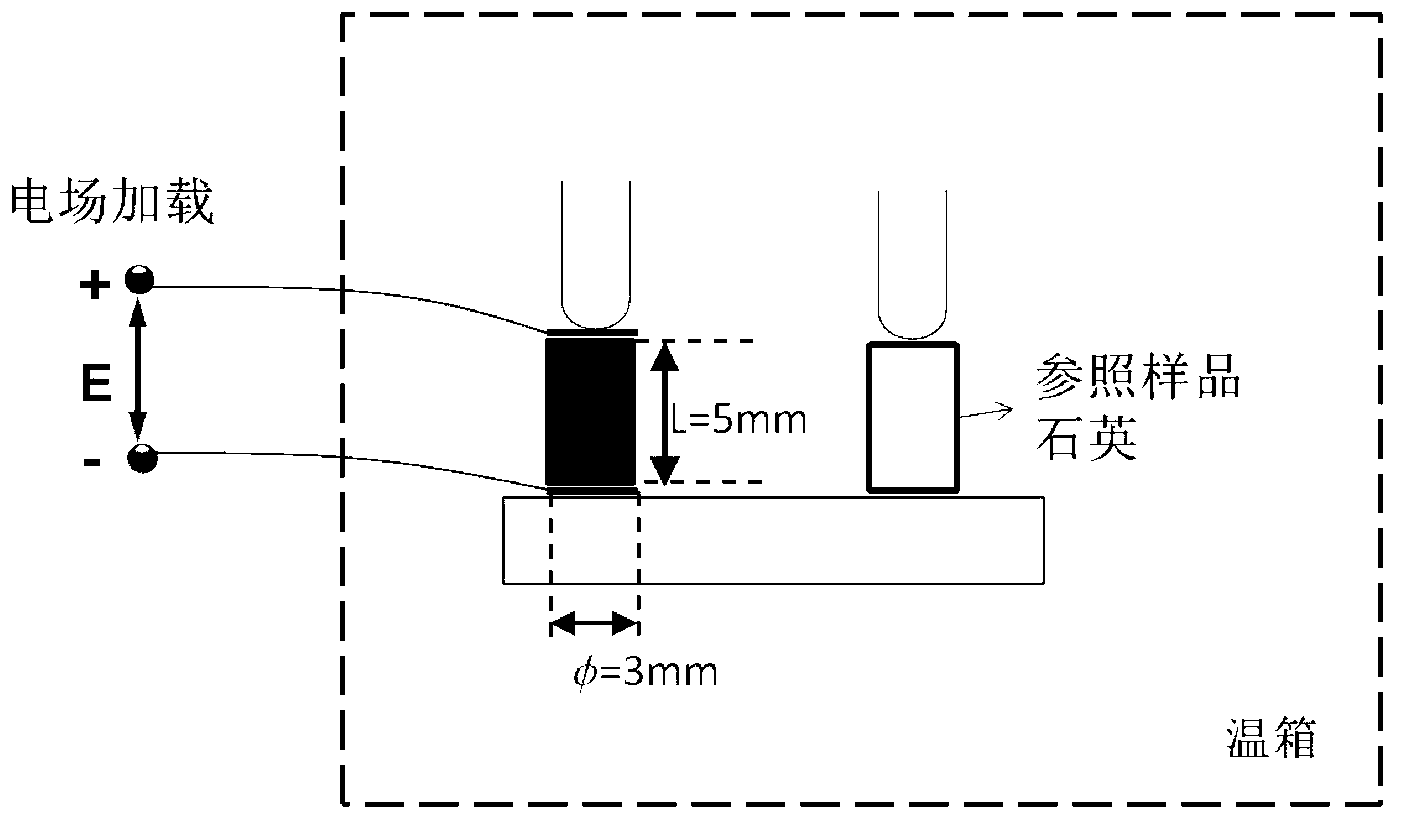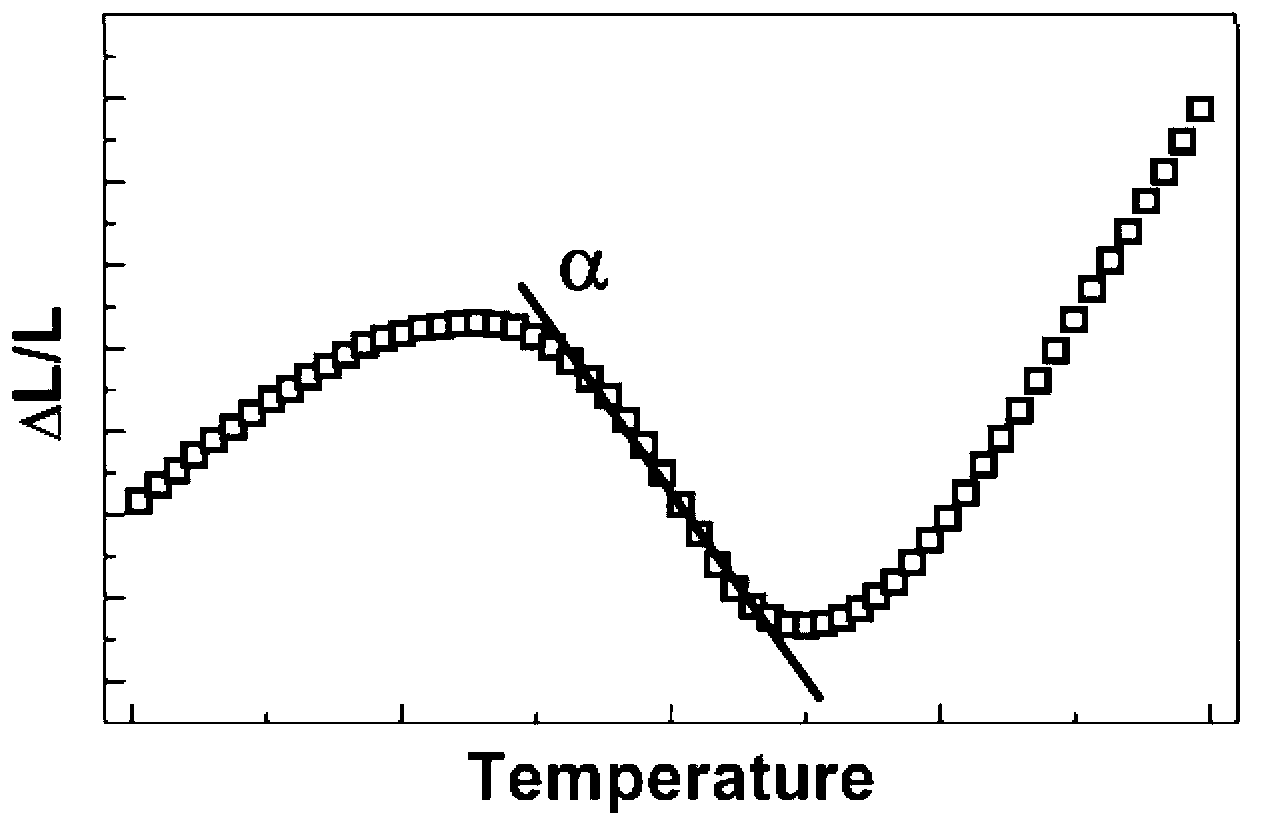Method for adjusting thermal expansion based on relaxation ferroelectric phase-transition electric fields
A technology of electric field regulation and ferroelectric phase, applied in the field of electric field regulation of thermal expansion behavior based on relaxor ferroelectric phase transition, and electric field regulation of thermal expansion behavior, which can solve problems such as shortening component life and accelerating material failure, and achieve the effect of avoiding thermal stress.
- Summary
- Abstract
- Description
- Claims
- Application Information
AI Technical Summary
Problems solved by technology
Method used
Image
Examples
Embodiment 1
[0030] (1) Select Pb(Zr 0.4 Ti 0.6 )O 3 As a matrix ferroelectric material, it undergoes a cubic (paraelectric phase) to tetragonal (ferroelectric phase) ferroelectric phase transition during cooling, accompanied by volume expansion of the material.
[0031] (2) La is selected as the doping element instead of Pb to form La-substituted Pb-type point defects. Materials with different La content (Pb 1-x La x )(Zr 0.4 Ti 0.6 )O 3 . Dielectric performance tests show that with the increase of La content, the ferroelectric phase transition temperature from cubic (paraelectric phase) to tetragonal (ferroelectric phase) decreases sharply. When the La content exceeds its critical value (16%), the ferroelectric phase transition is completely suppressed, and the material undergoes a relaxation ferroelectric phase transition.
[0032] (3) The in-situ transmission electron microscopy test during the cooling process showed that (Pb 0.83 La 0.17 )(Zr 0.4 Ti 0.6 )O 3 A part of th...
Embodiment 2
[0035] (1) Select PbTiO 3 (abbreviated as PT) is a matrix ferroelectric material, which undergoes a cubic (paraelectric phase) to tetragonal (ferroelectric phase) ferroelectric phase transition during cooling, accompanied by volume expansion of the material.
[0036] (2) Select Pb(Mg 1 / 3 Nb 2 / 3 )O 3 (PMN for short) as doping, with PbTiO 3 The matrix mixes, forming defects. Materials with different PMN contents (xPMN-(1-x)PT) were prepared by solid-state sintering. Dielectric property tests show that with the increase of PMN content, the ferroelectric phase transition temperature from cubic (paraelectric phase) to tetragonal (ferroelectric phase) decreases sharply. When the PMN content exceeds its critical value (70%), the ferroelectric phase transition is completely suppressed, and the material undergoes a relaxation ferroelectric phase transition.
[0037](3) The in-situ transmission electron microscopy test during the cooling process shows that a part of the high-tempe...
Embodiment 3
[0040] (1) Choose BaTiO 3 As a matrix ferroelectric material, it undergoes a cubic (paraelectric phase) to tetragonal (ferroelectric phase) ferroelectric phase transition during cooling, accompanied by volume expansion of the material.
[0041] (2) Select Sn as the doping element instead of Ti to form Sn-substituted Ti-type point defects. Materials with different Sn contents Ba(Ti 1-x sn x )O 3 . Dielectric property tests show that the cubic-to-tetragonal ferroelectric phase transition gradually disappears with increasing Sn content. When the Sn content exceeds its critical value (19%), the ferroelectric phase transition is completely suppressed, and the material undergoes a relaxation ferroelectric phase transition.
[0042] (3) In situ transmission electron microscope test during the cooling process showed that Ba(Ti 0.8 sn 0.2 )O 3 A part of the high-temperature paraelectric phase in the material transforms into nanometer-sized ferroelectric domains (triclinic), and...
PUM
 Login to View More
Login to View More Abstract
Description
Claims
Application Information
 Login to View More
Login to View More - R&D
- Intellectual Property
- Life Sciences
- Materials
- Tech Scout
- Unparalleled Data Quality
- Higher Quality Content
- 60% Fewer Hallucinations
Browse by: Latest US Patents, China's latest patents, Technical Efficacy Thesaurus, Application Domain, Technology Topic, Popular Technical Reports.
© 2025 PatSnap. All rights reserved.Legal|Privacy policy|Modern Slavery Act Transparency Statement|Sitemap|About US| Contact US: help@patsnap.com


